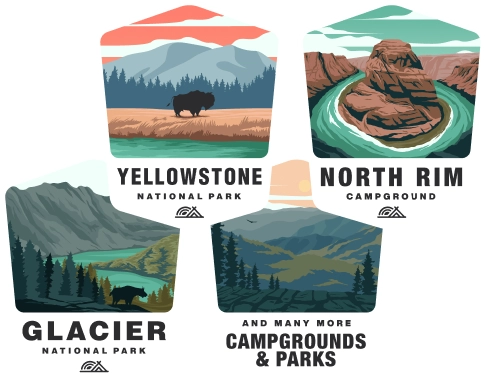Camping at Big Bend National Park
Introduction
Big Bend National Park, located in western Texas, is a remote park renowned for its stunning natural features, including river canyons, desert landscapes, and diverse wildlife. To ensure a safe and enjoyable camping experience in Big Bend National Park, it's essential to have up-to-date information on campsites, permits, weather, safety, and park regulations.
Campsites and Lodging
Developed Campgrounds:
- Chisos Basin Campground: Situated in the mountains with close proximity to hiking trails. It has limited RV space due to its tight turns and elevation.
- Rio Grande Village Campground: Nearest to the Rio Grande with sites for tents and RVs. It has some amenities and a nearby store.
- Cottonwood Campground: A quiet, more secluded option, ideal for tents and smaller RVs, located near the Castolon Historic District.
Primitive Backcountry Campsites:
- Backcountry camping is available for those seeking a more rugged experience. This includes both roadside sites for vehicles and backpacking sites for those hiking into the desert or mountains.
RV Camping:
- RV sites with full hookups are available at the Rio Grande Village RV Campground operated by a park concessioner.
Lodging:
- For those who prefer not to camp, the Chisos Mountains Lodge provides hotel-style accommodations within the park.
Permits and Reservations
Permits:
- Backcountry use permits are required for all overnight stays in the backcountry, including backpacking and primitive roadside campsites.
- Permits can be obtained at visitor centers and are available up to 24 hours in advance of your trip.
Reservations:
- Reservations for developed campgrounds can be made in advance through the National Recreation Reservation Service.
- Some sites are first-come, first-served, but due to the park’s popularity, it is highly recommended to book in advance, especially during peak seasons.
Weather and Climate
- The park has a desert climate with hot summers and mild winters.
- Summer: Daytime temperatures can exceed 100°F, making hiking and other strenuous activities dangerous during peak heat.
- Winter: Nighttime temperatures can drop below freezing, especially in the Chisos Mountains.
- It's important to check the forecast before your visit and prepare accordingly with clothing, sunscreen, and ample water.
Safety Tips
- Hydration: Drink plenty of water. Dehydration is a common issue for visitors.
- Wildlife: Be aware of potentially dangerous wildlife, including snakes, scorpions, and mountain lions.
- Heat: Avoid strenuous activity during the heat of the day in summer months.
- Flash Floods: Be alert to the risk of flash floods, particularly in canyons and during rainstorms.
- Navigation: GPS units can be unreliable; bringing a map and compass is advisable.
Park Regulations
- Wilderness Protection: Follow Leave No Trace principles to minimize impact on the natural environment.
- Fires: Wood fires are not permitted anywhere in the park. Containerized fuel stoves are allowed in certain areas for cooking.
- Pets: Pets are allowed in the park but are restricted to certain areas and must be on a leash. They are not allowed on most trails, in the backcountry, or in any park buildings.
- Quiet Hours: Observe quiet hours in campgrounds typically from 8 p.m. to 8 a.m.
Conclusion
Camping in Big Bend National Park offers a unique chance to immerse yourself in the beauty and solitude of the Chihuahuan Desert. With adequate preparation and an understanding of the park's regulations, you can ensure a memorable and respectful visit to one of Texas's natural treasures. Always check the National Park Service's official Big Bend National Park website or contact the park directly for the most current information and conditions before you visit.

